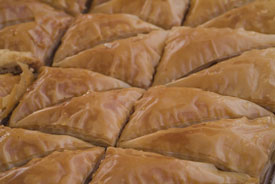Phyllo
 |
Baklava and Spanakopita (spinach pie) are the two most-referenced recipes that use phyllo dough. |
Phyllo (filo, fillo) is the papery-thin dough used with many types of sweet and savory fillings. It is always buttered and layered – typically with 5-20 sheets - before any ingredients are added. The result is a crisp and wonderfully flaky crust or wrapping. While it is a simple combination of water, flour, and oil, the sheets are so delicate that some experience is required when handling or making from scratch.
History
The exact origin of this pastry dough is debatable. The term phyllo means “leaf” in the Greek language, but many guess that the recipe originated in . It is known by other names: ouarka (), breik (), bourekia (), and strudel ().
Traditionally, it was deemed so difficult to make that girls went into training at the age of five. They were not considered accomplished until many years later.
Varieties
Fresh dough is available at some specialty markets. Because it has not been frozen it is easier to manipulate.
Frozen phyllo is more convenient, however, and can remain in the freezer up to four months.
Varying thicknesses are available: #7 is thinner and best for sweet dishes while a #4 is better suited to heartier foods such as meats and vegetables.
Size of sheets will also vary, but amounts are usually sold in one-pound packages. The sheets are rolled together and must be unwrapped very carefully.
Pre-formed shapes, such as muffin cups, are also sold and are ideal for individual quiches.
Buying Tips
For frozen dough, purchase packages with the longest “use” or “sell” date.
Always purchase a little extra. While most rips and tears can be patched, some sheets may be lost in the process.
Storage Tips
Frozen dough can remain in the freezer for up to four months. If baked first, it is good for about one month.
Usage Tips
• Thawing – about 24 hours in the refrigerator - is critical to the success of pastry-making.
• Always have plenty of plastic wrap available to protect sheets from drying and cracking.
• Score the dough before baking to make it easier to cut.
• Phyllo dishes cannot be prepared in the microwave.
• For recipes that don’t require shaping, the dough can be baked ahead of time and then layered.
• Always have the other ingredients prepared before buttering sheets. You will need to work quickly once the dough has been removed from the refrigerator.
• To reduce fat and calories, use cooking spray instead of butter to coat the layers.
Substitution Tips
Use puff pastry instead.
Try one of our favorite phyllo recipes:
Baklava





